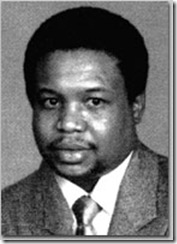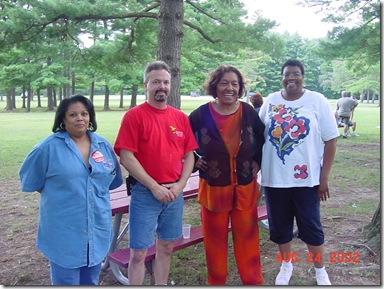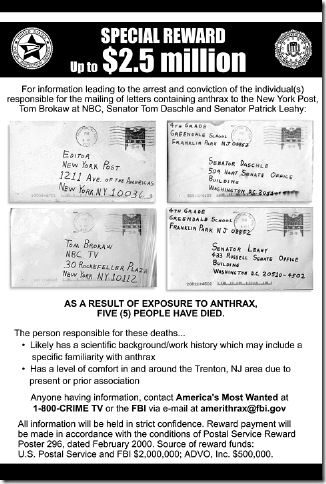reprinted from the 10th Anniversary (2011)
On Sept. 11, 2001 terrorists hijacked four airline jets and crashed them into the World Trade Center towers in New York City, the Pentagon in Virginia and a field in rural Somerset County, Pa. There is no need to remind anyone of this event as it is ingrained in the psych of any American who was old enough to comprehend that something was different that day.
Just as with Pearl Harbor, John F. Kennedy’s assassination, Armstrong walking on the moon and the day the shuttle exploded, we all know where we were and what we were doing when those events happened. We say never forget, and we shouldn't, for these are events that define us as a nation and a people, but as time goes on the vividness of the event remains with us but our memory of surrounding events tend to fade.
Few were ever aware of the heroism and fate of the African-American cook who, untrained, manned a machine gunned and returned fire before being ordered to abandon ship at Pearl Harbor. In the case of the Kennedy assassination few remember the police officer that Lee Harvey Oswald gunned down after killing the President. How many of us can remember the name of Neil Armstrong's crew? Even less can probably name more than one member of the Challenger crew.
The events of September 11, 2001 will remain in our psyche forever, but like the other great events, the details will become items that have to be looked up in history books in order to refresh our memories. September 11, 2001, like Pearl Harbor, was not a culminating event. The two may have marked an end to a certain national innocence, but they were more significant as they marked the beginning of a new national awareness that moved the nation forward.
Just as Dorie Miller, J.D. Tippit, Buzz Aldrin do not leap out of our memories in a flash, neither does Thomas Morris or Joseph Curseen.
Every September since 2001 our national attention appropriately turns to memorializing the victims of 9/11. While this attention is totally justified it is ironic that what was perceived as the biggest threat to the nation during the days that followed the attacks was the fear of bio-terrorism. Anthrax to be exact.On the day of the 9/11 attacks Vice President Cheney and his staff were given CIPRO as a precaution against Anthrax. This was before the anthrax was placed in the mail system and anyone had been exposed. The first letters containing anthrax would not be mailed for about a week. Once the anthrax letters started showing up and as long as the public thought the anthrax attacks were connected to the 9/11 attacks it was the countries greatest fear.
After 17 infections, including 5 deaths, the attention turned from the anthrax attacks as time passed. The letters ceased and the realization that the attacks were probably domestic in nature and not tied to the 9/11 attacks pushed the anthrax attacks from our public discussion and our collective memory.
| As little as a year later, on the anniversary of the 9/11 attacks, then IAL-President Eddie Beaver and I manned a booth on the Circle during the cities first 9/11 Community Fair passing out fliers about the steadfastness of Postal Workers during the anthrax attacks. We were astonished how many people were surprised to be reminded about the anthrax attacks. Most people had forgotten about anthrax or had absorbed those events into the whole Islamic terrorism memory of 9/11. |
As postal workers we can take pride in our diligence and commitment during that hectic year.
So on this the 10th anniversary of both the 9/11 attacks and the anthrax attacks let's remember both events. Let's remember the two Postal Workers that died from anthrax exposure: Joseph Curseen and Thomas Morris (brother of Cumberland Window Clerk Sheila Howard) and let's remember how as we came to work every day we were the first responders to the anthrax attacks.
THE CREED
"Neither snow, nor rain, nor heat, nor gloom of night stays these couriers from the swift completion of their appointed rounds" 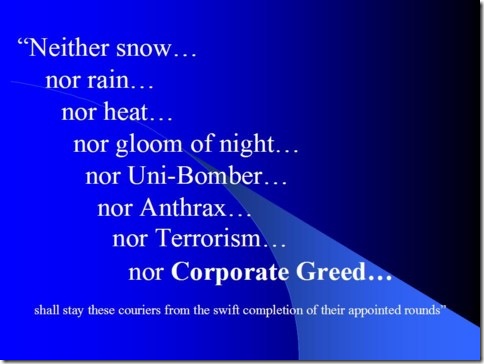
Since the establishment of Postal Service in 1775 by the Second Continental Congress, Postal Workers have routinely been placed in harms way: 
- Exposed to the hazards of frontier life and armed robberies from the early Colonial "Post Riders" to the experimental Railway Mail Service of 1862.
- From the brief but dangerous existence of the Pony Express, exemplified by the newspaper recruitment advertisements that read "Wanted: Young, skinny, wiry fellows not over 18. Must be expert riders willing to risk death daily. Orphans preferred."
- From the death of the three American "Sea Post Clerks" in service aboard the HMS Titanic in 1912 and more through two World Wars.
- From the early days of aviation and the experimental testing of mail delivery by air to the modern day "Unabomber".
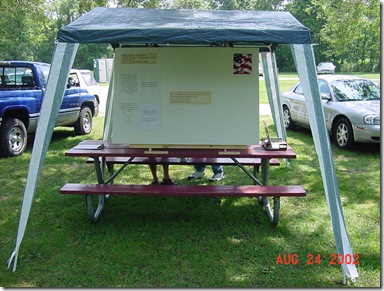 We collected over 3000 signatures and turned the Post Card over to Rep. Julia Carson to deliver to the Brentwood Area Local in Washington. |
| With the death of Postal Workers Thomas Morris, Jr. and Joseph Curseen, Postal Workers entered the age of bio-terrorism. In 2001 Postal Workers across the country demonstrated that the creed is more than an outdated reference to their duties. It exemplifies the dedication of Postal Workers to their work, the sanctity of their duties, and the significance of the U.S. Mail to the history and security of the country. When the country was paralyzed by the events of September 11, 2001 and horrified by the subsequent anthrax attacks, Postal Workers continued in their duties without missing a beat. When Congress closed its doors because of the delivery of anthrax laden mail, the Postal Workers that delivered and processed that mail did not cower in their duties. When it was discovered that materials from contaminated postal facilities where delivered to the Critical Parts Center in Indianapolis, the 'non-postal' facility was immediately closed down. Indianapolis Postal Workers at the facilities and offices that delivered that material continued to perform their duties without interruption. With 20 postal facilities testing positive for anthrax contamination, Postal Workers in overwhelming numbers continued to report for work, well aware of the potential dangers. Postal Workers across America continue to display a dedication to their daily duties that is only surpassed by the members of our Armed Forces and our unionized brothers and sisters in Police and Fire Departments across the country and unmatched in the private sector. |
Timeline Of The Attacks
|
- http://en.wikipedia.org/wiki/2001_anthrax_attacks
- http://online.wsj.com/article/SB10001424052748704541004575011421223515284.html
- http://www.justice.gov/amerithrax/docs/amx-investigative-summary.pdf
- http://www.fbi.gov/about-us/history/famous-cases/anthrax-amerithrax/
- http://www.nydailynews.com/news/national/2008/08/02/2008-08-02_fbi_was_told_to_blame_anthrax_scare_on_a.html
- http://www.wnd.com/news/article.asp?ARTICLE_ID=51917
- http://www.nytimes.com/2002/03/23/us/nation-challenged-bioterrorism-report-linking-anthrax-hijackers-investigated.html
- http://www.jaoa.org/cgi/content/full/104/11/452
- http://transcripts.cnn.com/TRANSCRIPTS/0110/26/ltm.08.html
- · http://en.wikipedia.org/wiki/Timeline_of_the_2001_anthrax_attacks
- · http://www.npr.org/2011/02/15/93170200/timeline-how-the-anthrax-terror-unfolded
- · http://www.postalmuseum.si.edu/duty/terrorinthemail.html
- The Minneapolis Star Tribune, CNN and wire services contributed to some the above sources.
For more on Dorie Miller, J.D. Tippit, Buzz Aldrin and the Challenger crew ‘left-click’ on their names.


